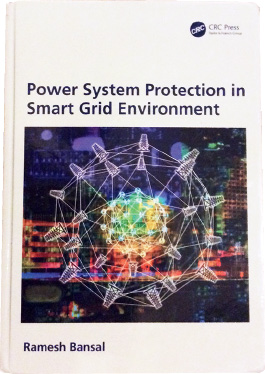First Edition
by Ramesh Bansal

research and industry.
One of the biggest drivers for the developments in electric power systems protection is the transition from the “conventional” grid of the last century into the Smart Grids of today. That is why many specialists in our industry are looking for sources of information that will help them understand the impact of the different components of the smart grid on protection devices and systems.
This book, with its more than 600 pages may be one such source. Professor Ramesh Bansal, the editor of the book, has more than 25 years’ experience in teaching, research and industry. He is currently based in the College of Engineering at the University of Sharjah, UAE. Prior to this, he worked at universities in South Africa, Australia, Fiji and India. He has worked also for Powerlink, in Australia. This worldwide experience combining utility problem solving, academic research and teaching establishes a solid foundation for a good understanding of the challenges that power system protection faces in the smart grid environment and addressing them in the book. He has assembled a team of more than twenty academics and researchers from South Africa and India contributing to the eighteen chapters of four sections in the book.
Section I is dedicated to faults analysis and power system protection devices. Chapter 1 presents an overview of smart grid in protection perspective, followed by fundamentals of fault analysis in Chapter 2. The next three chapters discuss fuses and circuit breakers, instrument transformers and protective relaying systems.
Section II of the book focuses on feeder and transmission line protection. The four chapters of this section are dedicated to medium voltage phase overcurrent feeder protection, bus-bar protection, distance protective relaying systems for long transmission lines and protection of reactors and FACTS devices.
Section III is dedicated to equipment protection described in five chapters: transformer protection, generator protection systems, induction motor protection, substation automation and control and overvoltage and earthing protection.
The last section of the book includes four more chapters that cover power quality and equipment protection, reliability assessment of the distribution system in the presence of protective devices, advances in wide area monitoring, protection and control, as well as protection of renewable distributed generation systems.
Each chapter in the book starts with an introduction, followed by detailed discussion of the specifics of the topic. At the end of each chapter the authors include tutorial problems, conclusions and a list of references.
The intended audience of the book is senior undergraduate and gradate students, researchers and professionals working on electric power system protection and control issues. As can be seen from the content of the different sections of the book, it covers a wide range of topics describing the impact of the various smart grid related technologies on protection and control systems. Considerations of the integration of Distributed Energy Resources (DER), IEC 61850, synchrophasors and their use for substation protection, automation and control systems, as well as wide area monitoring, and System Integrity Protection Schemes highlight the main factors that need to be analyzed as part of the design of protection systems in a Smart Grid environment.
The practical approach to the presentation of the material in the book makes it a useful tool for the intended audience.
Power System Protection in Smart Grid Environment
by Ramesh Bansal
Hardcover: 636 pages
Published by CRC Press – Taylor & Francis Group
ISBN-10: 1138032417
ISBN-13: 978-1-138-03241-5








